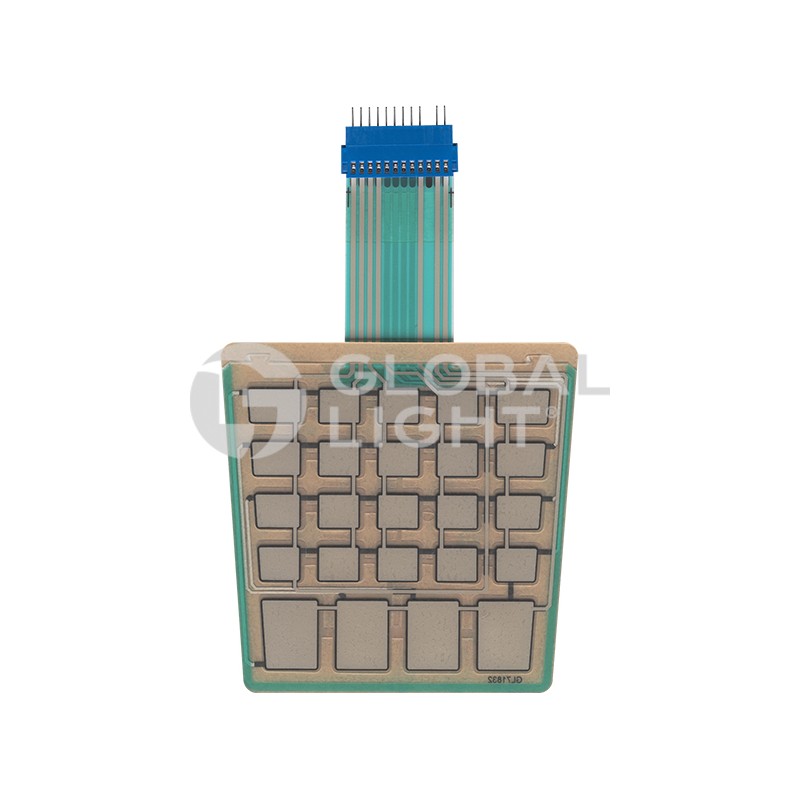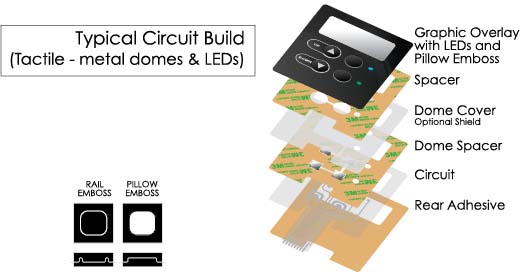Top Features to Look for in a High-Quality Membrane Switch
Top Features to Look for in a High-Quality Membrane Switch
Blog Article
Understanding Membrane Layer Switches: The Key to Long Lasting and Reliable Controls

What Are Membrane Buttons?
Membrane layer buttons are a sophisticated service in the realm of interface modern technology, incorporating functionality and design perfectly. These gadgets function as a user interface in between customers and digital systems, incorporating numerous elements right into a compact format. Usually built from versatile, slim layers of products, membrane layer switches are developed to reply to touch, making it possible for users to communicate with machinery and electronic devices efficiently.
The main elements of a membrane switch consist of a published circuit layer, visuals overlay, and a spacer layer that protects against unplanned activation. The graphic overlay can be personalized to show brand identity or customer choices, boosting appearances while ensuring use. Membrane layer buttons are frequently utilized in various applications, consisting of medical tools, customer electronic devices, and industrial devices, owing to their sturdiness and resistance to environmental elements such as moisture and dirt.
One of the key advantages of membrane switches is their ability to hold up against deterioration, making them excellent for high-traffic settings. In addition, they are lightweight and call for minimal room, allowing for innovative styles in item advancement. In general, membrane switches over represent a effective and practical selection for contemporary electronic user interfaces, marrying innovation with user-centric design concepts.
Exactly How Membrane Changes Job
The procedure of membrane layer changes rest on a straightforward yet efficient mechanism that equates customer input into digital signals. These buttons include several layers, generally consisting of a graphic overlay, a spacer layer, and a circuit layer. When an individual presses the button, the top layer flaws, allowing a conductive aspect in the circuit layer to make contact with a matching conductive pad on the bottom of the graphic overlay. This call closes the circuit and sends a digital signal to the tool, indicating that the button has actually been triggered.
The layout of membrane switches can vary, however they commonly incorporate domes or responsive elements to supply responses to the customer, enhancing the overall experience - membrane switch. The materials utilized in membrane layer buttons, such as polyester or polycarbonate, add to their resilience and resistance to environmental aspects, consisting of moisture and dust. Additionally, the printed circuits are usually enveloped, which secures them from deterioration with time.
Advantages of Membrane Switches

Furthermore, membrane layer buttons are recognized for their sturdiness. Built from durable products, they are immune to dirt, dampness, and physical wear, which significantly extends their life expectancy compared to conventional mechanical switches. This toughness makes them specifically ideal for high-traffic settings and applications calling for long life.
Another considerable advantage is the simplicity of cleaning and maintenance. The smooth surface of membrane switches minimizes dust buildup and is frequently unsusceptible spills, making them optimal for settings that need regular sanitization.
Furthermore, membrane switches supply a structured account, recommended you read resulting in a thinner design that can be incorporated right into different gadgets without adding bulk. This attribute not just improves the aesthetic go now allure yet also adds to a much more ergonomic product design.
Applications of Membrane Layer Buttons
Flexible and user-friendly, membrane buttons locate applications across a variety of sectors, including clinical gadgets, consumer electronic devices, and commercial equipment. In the clinical field, these buttons are essential to devices such as analysis equipment, person tracking systems, and infusion pumps, where integrity and convenience of cleansing are vital. Their ability to keep and hold up against severe atmospheres capability makes them excellent for such applications.

In consumer electronic devices, membrane switches are made use of in products like microwaves, cleaning equipments, and push-button controls - membrane switch. Their smooth design enables for instinctive user interfaces, improving the total user experience while supplying longevity and resistance to tear and put on
Industrial equipment likewise profits from membrane buttons, especially in control panels for equipment and automation systems. These buttons provide security versus dirt and moisture, guaranteeing regular efficiency in challenging atmospheres. In addition, their personalized features permit producers to customize them to details functional demands, enhancing effectiveness and performance.
Selecting the Right Membrane Layer Change
When picking a membrane layer button, it is important to consider various factors that influence efficiency and suitability for particular applications. The primary considerations consist of ecological problems, tactile comments, longevity, and layout requirements.
First, analyze the operating setting; buttons subjected to moisture, chemicals, or extreme temperatures need certain materials to guarantee longevity and capability. Next off, review the demand for responsive comments. Depending on customer interaction, some applications may take advantage of a responsive reaction to confirm activation, while others might choose a non-tactile design for visual reasons.
Durability is an additional essential aspect; membrane here buttons ought to be designed to hold up against regular usage, impacts, and abrasion. Make sure the selected button can endure the anticipated lifecycle, especially in high-usage situations.

Final Thought
In conclusion, membrane switches over serve as crucial components in the style of durable and trustworthy control systems across numerous industries. The adaptability of membrane layer switches allows for tailored remedies that meet particular functional demands, reinforcing their importance in contemporary innovation.
Membrane layer switches represent an essential element of modern-day user interface design, blending functionality with strength in various applications.Membrane switches are a sophisticated solution in the world of customer interface technology, incorporating performance and design perfectly. Typically constructed from flexible, thin layers of materials, membrane layer buttons are created to react to touch, making it possible for customers to connect with equipment and digital devices effectively.
The design of membrane buttons can differ, yet they usually include domes or responsive components to give responses to the customer, enhancing the overall experience.In conclusion, membrane layer switches over offer as crucial parts in the style of dependable and durable control systems across numerous markets.
Report this page